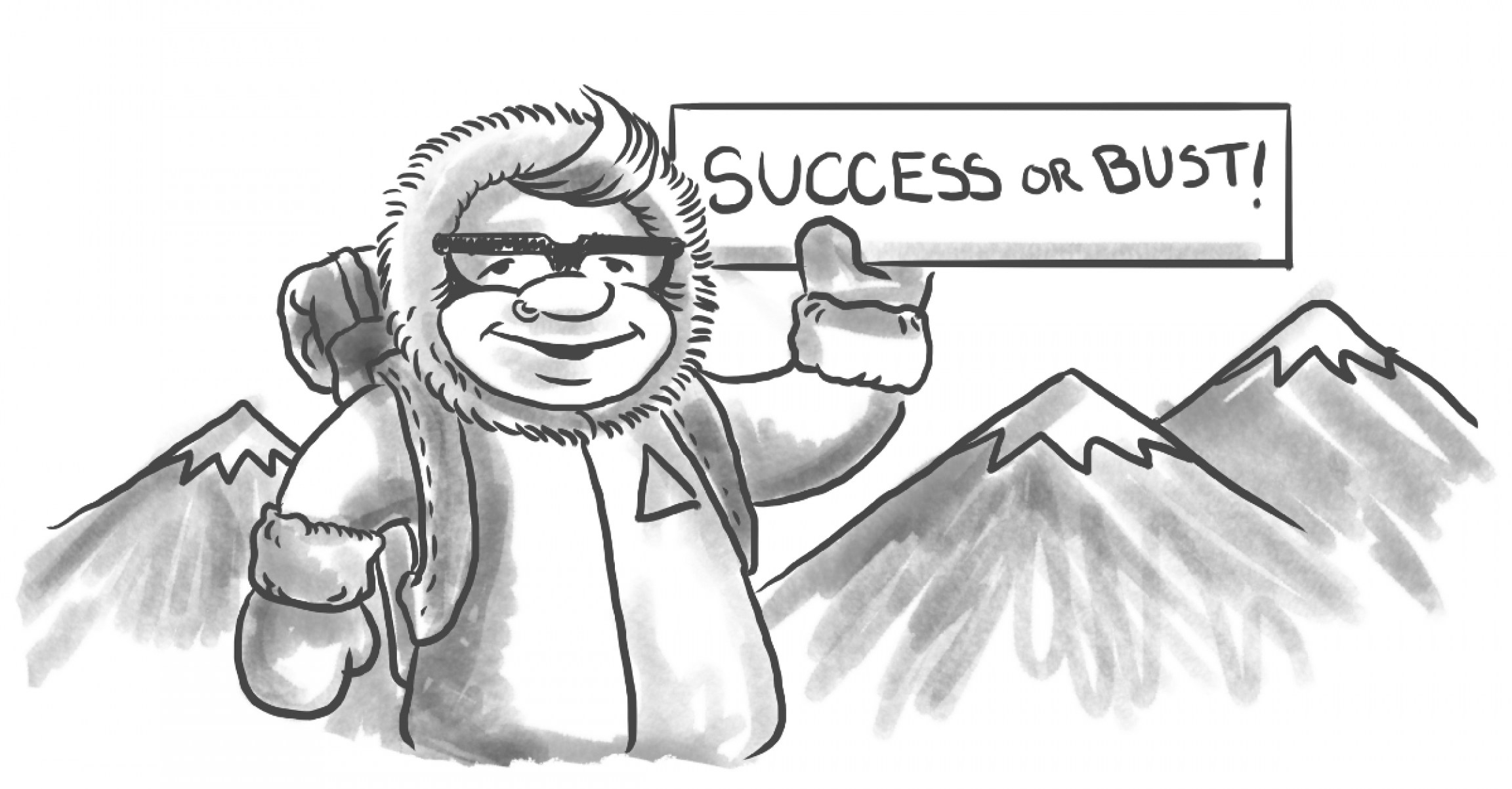Milestone One
Entrepreneurship
Grammar Lesson: Startup Is A Verb
Every city’s got a startup scene, especially the smaller ones, the underdogs. I love my city, and yeah, we’ve got one, too. Good ol’ Memphis, Tennessee. Swap out the details and this will sound a lot like your own city.
In Memphis, we’re known for barbecue and Elvis, FedEx and trucking. Lots of other good stuff, too. And when you go downtown, we’ll see to it that you’re well-fed while we brag about our thriving high-tech startup scene. Memphis was mentioned in the 500 Startups twitter feed, which is a testament to what we can accomplish when we pool our resources and give tech-savvy entrepreneurs the resources and access they need.
That’s right, if you work hard, you can get mentioned in a tweet, or an article, or on a podcast. You, too, can be a cog in a more successful organization’s content strategy.
“We’ll see to it that you’re well-fed while we brag about our thriving high-tech startup scene.”
So what is the missing piece? What is the thing I’m suggesting that will give you a better chance at succeeding with your business idea?
I call it Milestone One: a clear focus on getting your startup cash flow positive first. Stop chasing the unicorn dream, the miracle exit, or the hope that you’ll monetize it later when you have users.

But it’s more than cash flow positive. It’s really about being cash flow positive enough to afford to support yourself and your family, to put a roof over your head.
And to be sure, we have lots of successful small businesses that thrive off of our established logistics economy and healthcare scene. But come on, let’s be honest. My city ain’t Silicon Valley. It won’t ever be, either.
That doesn’t mean we don’t have successful “high tech” software and product companies, though. We do. We have quite a few of them, actually. Good ones. Established ones. Ones you’ve never read about in TechCrunch, but they’re doing good business anyway (despite their generally miserable, outdated design aesthetics).
But lots of cities have successful software companies (with bad interfaces). And whether we’re talking about my city or yours, those successful software companies probably didn’t emerge from a downtown incubation factory on a $25,000 seed round and a year of mentoring from local executives and startup experts with an opportunity to pitch to real angel investors at the demo day.
These companies are employing 20, 40, 100, 250 well-paid employees a pop and are providing critical services to the world’s leading companies. They’ve been around for twenty years or more. Some have been around since the ’60s. Yeah, software companies that have been around since the ’60s, going on fifty years of covering their nut and having plenty left over.
Fail Easy, Fail More Often: the Gap Year for Entrepreneurs
These cities all have some sort of egg hatching metaphor for these things. The idea is that the programs keep little eggs warm and nurture them while they’re fragile. It’s a nice thought, it really is, but people who start successful businesses aren’t delicate little eggs, they’re triple-tempered steel. I have a different phrase I use when talking about these hatcheries — I call them gap years for entrepreneurs.
“People who start successful businesses aren’t delicate little eggs, they’re triple-tempered steel.”
I asked my wife what she thought of gap years. She said, “I think they’re dumb.” Then, she paused and reflected. “But maybe,” she decided, “they’re okay and I’m just jealous that I didn’t have one.”
That’s a fair point. And I’m not trying to be unfair, because there’s more to it than that. You may want to hear what I have to say if you’re interested in starting a business that has a higher likelihood of succeeding and lasting than a startup. A gap year is what people do when they want a break from the slog and want to get experiences.
This isn’t easy to swallow for a lot of people who dedicate so much energy and money bringing these programs to life and helping founders with their businesses, but that doesn’t mean it’s inaccurate.
“A gap year is what people do when they want a break from the slog and want to get experiences.”
To be certain, I have strong relationships with the folks in my city, and cities all over, trying to make a real go of their startup scenes. It’s a good battle to be fighting, but in Memphis and in your city, it doesn’t do any good for us to fool ourselves into thinking startup hatcheries are the formula for building a better local economy.

I think they’re great for helping entrepreneurs get practice at doing business things and driving investment in revitalizing downtowns, but I’m interested in helping people succeed at business things in every neighborhood. Yes, even the suburbs.
We build better, bigger local economies when businesses succeed. Startups have a terrible success rate. It’s not because they’re working on bad ideas, it’s not because the founders and advisors aren’t smart, and it’s especially not because the talent isn’t there. The talent is there. The passion is there. The hard work is there. The ideas are solid. The business advice is real. The mentors are real.
These programs aim to give entrepreneurial minded people a head start on building a business, because starting a business is hard.
“We build better local economies when businesses succeed.”
But it should be hard. It should be scary. You do have to sacrifice. Tough choices force you to act on difficult decisions, to put up or shut up. These programs drive entrepreneurs hard, very hard. I’ve got no problem with that.
The problem is that these programs are trying to give entrepreneurs a break from the personal responsibility of their own livelihoods, so that when their startups fail it’s relatively painless to move on to the next thing.
If we want to help startups succeed, this is illogical. Making it safe to fail, quite simply, makes it easier to fail.
Move To Our City: the Play Pretend Startup Life
Most of these startup programs have partners in place to incentivize founders to apply to their cohorts and move to their fair city. “We have it going on, you know. We were written up in Newsweek, you know. We’re a Top Eight Place to start up, you know. We have an insanely low cost of living, you know, it’s basically free here and we have an emerging creative class. Seriously. Please. Move here, we’ll make it easy. Promise.”
“When their startups fail it’s relatively painless to move on to the next thing.”
The fact is, every city is doing it, so your city needs to do it, too. Local angels want the warm and fuzzy feeling that comes with helping the city become attractive to millennials, and city leaders need to make investments in these things. Local papers eat this stuff up.
Like I said: I love my town, and you love yours. But pretty much every city in the U.S. says these things, and we’re all competing for B-list startup founders, trying to get them to take our economic development incentives, move here, start families, grow companies, and hire tons of well-paid, skilled people maybe one day.
But when these startups fail, I think it’s because we’re not holding them accountable for negative outcomes. We encourage startup founders to relocate by negotiating six-month lease terms in hip downtown condos, terms that align perfectly with the runway they are able to get from their seed round. They get free office space, with furniture. And access to a $15,000 coffee maker.

That isn’t the real world. That’s the play pretend startup life. If it fails, they don’t have anything tying them down, and they’ll move on to the next opportunity.
Take Failure Off The Table
Our investors and startup programs need to help entrepreneurs succeed in business by taking failure off the table as an option.
I can hear you now, parroting the Fail phrases. “But, but, Fail Fast, Fail Often or Fail Better or Fail Forward.” You’re missing the point. If you’re trying to make a real business, it can’t fail. If you are trying to build something that is going to make an impact on the world, that’s great, but you have to be able to support yourself with it first, which means it has to exist.
Smaller underdog cities need to stop swinging for the fence and just try to get on base.
The Thirty Year Business Plan
I think it’s ridiculous to let startup founders who’ve never built a real digital product try and build one in six months using other people’s money while learning to code — that sounds like a scholarship to me, an opportunity to “find yourself and gain real world experience.” Except it’s not really the real world.
And don’t get me started on pivoting. Decide what you want to make, something that has value. Make it. Then, sell it. Sell it over and over and over until you have enough money to do something better.
I’m not trying to discourage you from learning to make a digital product, not in the least. And I’m not being elitist and saying yours isn’t as good as one someone with more experience can make. I mean, it probably isn’t, but you have to start somewhere.

What I am saying is that it takes more than six months to figure it all out. So, start by figuring out less. Start by figuring out how to make a business that makes enough money to support numero uno. Then, build on that. Get better over six years, not six months.
On top of that, community leaders and investors need to put the founders’ livelihoods first and foremost, by incentivizing them with deals structured around cash flow and net income before lifestyle and unlikely exits.
Ten years ago, I was designing websites for whoever would pay me, for whatever they’d pay me, five hundred or a thousand dollars at a time. Today, I own several multi-million dollar businesses. But back then, this wasn’t my plan. My plan was to sell another $1,500 website to pay my mortgage for the month. And I did that over and over until I had enough money to quit my job and start Simple Focus. Then, I worked on Simple Focus until I had enough money to start buying SaaS apps.
The startup game is a game that a lot of serial entrepreneurs play. I have multiple businesses, but I don’t call myself a serial entrepreneur. I think of myself as a business owner.
“Today, I own several multi-million dollar businesses. But seven years ago, this wasn’t my plan. My plan was to sell another $1,500 website.”
I think of myself in this way because I am focused on building generational businesses that I’m able to live off of for thirty years, not eighteen months. And that means starting with Milestone One.
So, what is Milestone One?
Milestone One is the first thing your business needs to accomplish, which is providing enough cash flow to put a roof over your head. Everything else is a distraction.

When you look at small businesses that succeed, you see a common thread: the owners are committed to the long game. A thirty-year commitment ties your livelihood to your business’s success. People who succeed achieve Milestone One first, they create a company that pays for the roof over their head, provides for their livelihood, before anything else.
Your “startup” will only be successful if it provides the money for that, in whole, every 15th of the month like clockwork.
“When you look at small businesses that succeed, you see a common thread: the owners are committed to the long game.”
Before you worry about anything else, work towards Milestone One tirelessly, and don’t let anything else distract you from it.
When you start a real business, every single, solitary thing you do has to boil down to putting that roof over your head. You can’t provide salaries to employees unless you can provide for yourself or your family first. You can’t contribute anything valuable to your community unless your needs are taken care of. You don’t have the luxury of helping your city until you can help yourself.
And it’s not about being selfish. It’s just a plain, simple fact.
No matter where you’re at in life, when you decide to start a business, whether you’re a college dropout or a seasoned executive who’s been laid off after a thirty-year career, you have a certain lifestyle you have or want, and you have no business “doing a startup” that doesn’t provide that for you. It doesn’t matter how fancy or not fancy your particular roof needs to be, you need to start a business that can cover that first.
...
This post was originally published on Medium .
...
Original illustrations by Travis Knight from Simple Focus.


